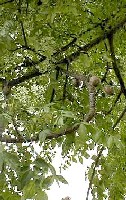| DESCRIPTION: It is a deciduous tree reaching 6-20 m in height with an open crown and laxly branched. Trees with 25 cm in stem diameter are common. The bark is grey, fairly smooth, furrowing with age. Leaves are a light, bright green, bipinnate with (sub)opposite leaflets, 3-7 per pinna and up to 35 cm long. The fruit is drupe-like and oval; colour changes from green to pale grey as the fruit matures. Fruit size is normally 4 cm long with a very thick, bony endocarp. USE: Fruit and leaves are used as fodder. The flowers are a source of honey. The wood is easily worked and shaped, making it suitable for making acoustic drums, containers, log bee hives and mortars. Leaf preparations are used as flea, mosquito and fly repellents. Useful in agroforestry since its deep rooting nature makes little interference with ox-plough cultivation. GROWING PERIOD: Perennial. COMMON NAMES: melia. FURTHER INF: It is common in association with acacia-commiphora vegetation. It is an emergent in acacia-commiphora deciduous bushland, sometimes fringing seasonal watercourses or appearing on rock outcrops. Physical characteristics of the soils in its natural range are sandy, clay and shallow stony. Good drainage is a common characteristic, although stands on sites classified as imperfectly drained soils in Tharaka-Nithi and Isiolo in Kenya have been reported. |
